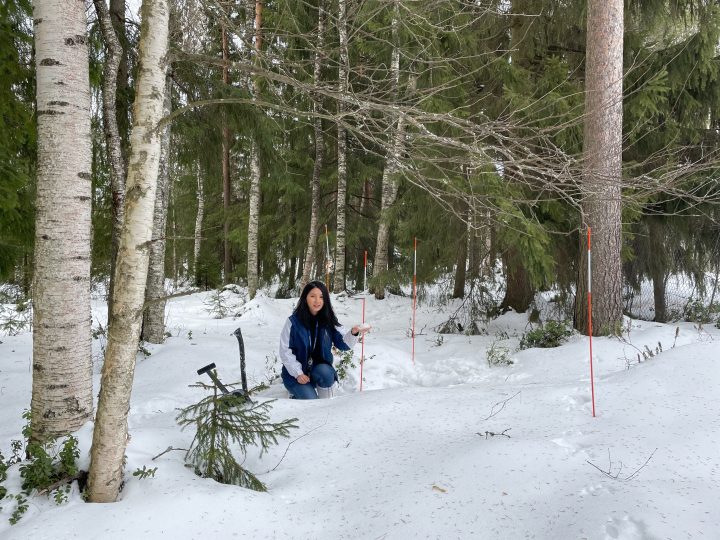What happens if the water intake of the billions of Finnish trees would change one day?
This spring we welcomed two new Research Council of Finland fellows in the Freshwater Competence Centre – last week we talked about the meandering rivers of the world that Elina Kasvi will research for the next four years – This week we are talking to Zuosinan Chen, new Research Council of Finland Fellow from University of Oulu, who wants to know how water moves through the Finnish boreal forest.

Zuosinan Chen comes from “the west of rivers” Jiang Xi in South China. There are lots of forests there, and seasonal summer rains, that Chen thinks have driven her passion to study water and trees. The only thing missing in her home region was the snow, and she has now found all these three elements she likes in Oulu, Finland.
If we start with the basics, the water intake of a tree is linked to the tree growth. The tree growth is linked to the carbon cycle, the ecosystem, and very, very strongly to our economy. What is more, changes in the water intake of the trees could have effects on the other water cycle outputs: how the water moves in the soil and then ‘reach’ the rivers, which is essential to local water resources. 75% of Finland is covered by boreal forests. There are so incredibly many trees in Finland that if their water intake changes, who knows what could happen elsewhere in the water cycle? Zuosinan Chen will spend the next four years trying to answer some questions about the water flow through the trees of Finland and how it influences other types of water movements in boreal forests. She does that with various sensors, including sap flow sensors.
Sap flow sensors measure the water movement in trees
The sap flow sensor has three needles that go into the root or the trunk of the tree. The middle needle sends a heat pulse at regular intervals and the needles on both sides measure temperature. In that way the sensor can tell how much and which direction the water inside the tree is flowing. “When I arrived in Finland, I sensed that though there are many researchers here working on forestry and hydrology, there is not a lot of work being done on how forests use water. Since the forests in northern Finland near the Arctic Circle are so close to the northern tree line in the world, and there are so many rivers and lakes in Finland, getting to know how forest consuming water under global warming is important for nature and also local human society.”
Other than how trees use water, how soil water is influenced by trees, could also be a complex matter. The sap flow sensors that were chosen for the project can measure the flow of water in both directions – going up and down the roots and the trunk. “Installing such sap flow sensors in the tree roots, we may be able to observe a phenomenon called hydraulic redistribution” Chen explains. Hydraulic redistribution is basically trees redistributing the soil water with their root system. The idea is, that in dry conditions, at night, the trees use their deep roots to absorb water from the relatively moist deep soil layers, but instead of fully transporting the water up to the trunk, they may also push part of the water out via shallow roots to the relatively dry surface soil, so that during the daytime, shallow roots have water to be used.
Where does the water in the trees come from?
While sap flow sensors measure the water flux in trees, Chen also wants to know where the water in the trees comes from. For that, she will be using the innovative water isotope probes and the Picarro Isotope Analyzer of Hydro RI Infrastructure of the Freshwater Competence Centre. Such a measurement system offers us the opportunity to track the source of water. It can provide answers to questions like which layers trees prefer soil water from, how much of the water intake is from winter snow, and how much is from summer rain? “We will build up a comprehensive and complex water isotope measurement setup in the Oulanka Research Station and Pallas catchment near and within the Arctic Circle”, Chen reveals.

Read more about water isotope analysis in this article about Heikki Ala-Aho’s work at University of Oulu
The boreal trees are facing changes in seasonal precipitation
Then comes the biggest question – why we need to worry about if and how the tree water use strategies may change? The grand scale of things is the climate change – the Arctic is facing more apparent warming than the global average and there are clear changes also in the seasonality of precipitation. In the winter we are seeing reduced snowfall and thinner snowpacks, in the spring, the snowmelt is finished earlier, and in the summer the rainfall is more variable. That means that the amount and the timing of the input into the water cycle is already changing. But what happens to the output when the water input changes? The two major outputs in terrestrial ecosystems are the river discharge and evapotranspiration, where water leaves the soil and goes back into the atmosphere. Majority of the water leaving the soil and going back into the atmosphere happens via the tree water use. This is not a minor phenomenon: in boreal forests, we are talking about 65% of the water leaving the soil into the atmosphere. “So tree water use is quite important for the local water cycle”, Chen explains, “These boreal forests have evolved under high precipitation seasonality of snow and rain. But now, under the global warming, this seasonality is changing.”

Chen thinks the boreal forests may not be used to the changing snow and rain, but how would they react is the big question. “We just don’t know that yet”, Chen concludes. One possible adverse effect could be damaging of the roots due to the thin snowpack that cannot protect the roots from freezing temperatures during winter and the spring frost. If the water intake capability of the roots is compromised, the early spring intake of the snowmelt water may fail and that could hinder the growth of the tree – spring is an important time for the tree growth. If the failed spring water intake could have further effects on the summer water intake of the trees is not known either yet, but hopefully after this project is completed, we will know more.
We wish the best of luck to Zuosinan Chen with her 4-year Academy fellow project!

